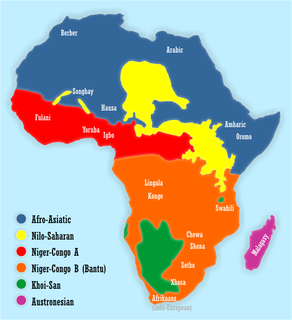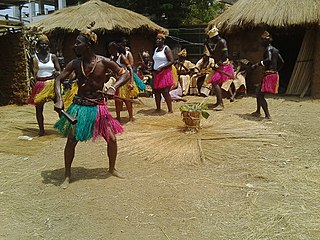
The Bantu languages are a large family of languages spoken by the Bantu peoples throughout sub-Saharan Africa.

Niger–Congo is a hypothetical language family spoken over nearly the entirety of Sub-Saharan Africa. It unites the Mande languages, the Atlantic–Congo languages, and possibly several smaller groups of languages that are difficult to classify. If valid, Niger–Congo would be the world's largest in terms of member languages, the third-largest in terms of speakers, and Africa's largest in terms of geographical area. It is generally considered to be the world's largest language family in terms of the number of distinct languages, just ahead of Austronesian, although this is complicated by the ambiguity about what constitutes a distinct language; the number of named Niger–Congo languages listed by Ethnologue is 1,540.

The Bantu expansion was a major series of migrations of the original Proto-Bantu-speaking group, which spread from an original nucleus around West-Central Africa across much of sub-Saharan Africa. In the process, the Proto-Bantu-speaking settlers displaced or absorbed pre-existing hunter-gatherer and pastoralist groups that they encountered.

Candomblé Bantu is one of the major branches (nations) of the Candomblé religious belief system. It developed in the Portuguese Empire among Kongo and Mbundu slaves who spoke Kikongo and Kimbundu languages. The supreme and creative god is Nzambi or Nzambi a Mpungu. Below him are the Jinkisi or Minkisi, deities of Bantu mythology. These deities resemble Olorun and the other orishas of the Yoruba religion. Minkisi is a Kongo language term: it is the plural of Nkisi, meaning "receptacle". Akixi comes from the Kimbundu language term Mukixi.

The Centre Region occupies 69,000 km² of the central plains of the Republic of Cameroon. It is bordered to the north by the Adamawa Region, to the south by the South Region, to the east by the East Region, and to the West by the Littoral and West Regions. It is the second largest of Cameroon's regions in land area. Major ethnic groups include the Bassa, Ewondo, and Vute.
Myene is a cluster of closely related Bantu varieties spoken in Gabon by about 46,000 people. It is perhaps the most divergent of the Narrow Bantu languages, though Nurse & Philippson (2003) place it in with the Tsogo languages (B.30). The more distinctive varieties are Mpongwe (Pongoué), Galwa (Galloa), and Nkomi.
Tetela, also Sungu, is a Bantu language of northern Kasai-Oriental Province, Democratic Republic of the Congo. It is spoken by the Tetela people.

The Bafia (Baepak) people inhabit the Mbam region in the Centre Region of Cameroon. Their origins are said to be similar with those of the Bamun, Nso and Tikar people. A division during migratory movements caused the two sets of groups to settle in different areas. Later, the Islamisation of most of the Bamun territory further separated them. A yearly festival held in Fumban is considered by many to symbolize the recognition of their common heritage. The 3 groups often refer to each other as Manjaras which is synonymous to cousins.

The 250 or so "Narrow Bantu languages" are conventionally divided up into geographic zones first proposed by Malcolm Guthrie (1967–1971). These were assigned letters A–S and divided into decades ; individual languages were assigned unit numbers, and dialects further subdivided. This coding system has become the standard for identifying Bantu languages; it was the only practical way to distinguish many ambiguously named languages before the introduction of ISO 639-3 coding, and it continues to be widely used. Only Guthrie's Zone S is (sometimes) considered to be a genealogical group. Since Guthrie's time a Zone J has been set up as another possible genealogical group bordering the Great Lakes.
Yao is a Bantu language in Africa with approximately two million speakers in Malawi, and half a million each in Tanzania and Mozambique. There are also some speakers in Zambia. In Malawi, the main dialect is Mangochi, mostly spoken around Lake Malawi. In Mozambique, the main dialects are Makale and Massaninga. The language has also gone by several other names in English, including chiYao or ciYao, Achawa, Adsawa, Adsoa, Ajawa, Ayawa, Ayo, Ayao, Djao, Haiao, Hiao, Hyao, Jao, Veiao, and waJao.
Kwangali, or RuKwangali, is a Bantu language spoken by 85,000 people along the Okavango River in Namibia, where it is a national language, and in Angola. It is one of several Bantu languages of the Okavango which have click consonants; these are the dental clicks c and gc, along with prenasalization and aspiration.
Ha, also known with the Bantu language prefix as Giha, Ikiha, or Kiha, is a Bantu language spoken by the Ha people of the Kigoma Region of Tanzania, spoken on the eastern side of Lake Tanganyika up to the headwaters of the Mikonga. It is closely related to the languages of Rwanda and Burundi; neighboring dialects are reported to be mutually intelligible with Kirundi.
The Bafia language is a Bantu language spoken by 60,000 people in Cameroon according to 1991 figures.
The Bafia languages are a clade of Bantu languages coded Zone A.50 in Guthrie's classification. According to Nurse & Philippson (2003), the languages form a valid node. They are:
Lika (Liko) is a poorly documented Congolese Bantu language of uncertain affiliation, though it has been included in Boan.
Kaalong (Kàlòng) also known as Dimbong (Mbong), is an almost extinct Bantu language from the Center Province of Southern Cameroon.
Bantu peoples are the speakers of Bantu languages, comprising several hundred indigenous ethnic groups in sub-Saharan Africa, spread over a vast area from Central Africa across the African Great Lakes to Southern Africa.
Hijuk is a minor Bantu language of Cameroon. Guthrie had left it unclassified within the Bafia languages (A.50), but according to Ethnologue 16, it has only 45% lexical similarity with Bafia, and 84% with Basaa.
Kwakum is classified as belonging to the Bantu subgroup A90 (Kaka) of the Zone “A” Bantu languages, and specifically labelled A91 by Guthrie. According to one of the newest updates to the Bantu classification system, other languages belonging to this subgroup are: Pol (A92a), Pɔmɔ (A92b), Kweso (A92C) and Kakɔ (A93). The Kwakum people refer to themselves as either Kwakum or Bakoum. However, they say that the "Bakoum" pronunciation only began after the arrival of Europeans in Cameroon, though it is frequently used today. Kwakum is mainly spoken in the East region of Cameroon, southwest of the city Bertoua.
Northern Bantoid is a branch of the Bantoid languages of the Niger–Congo language family. It consists of the Mambiloid, Dakoid, and Tikar languages of eastern Nigeria and west-central Cameroon.






